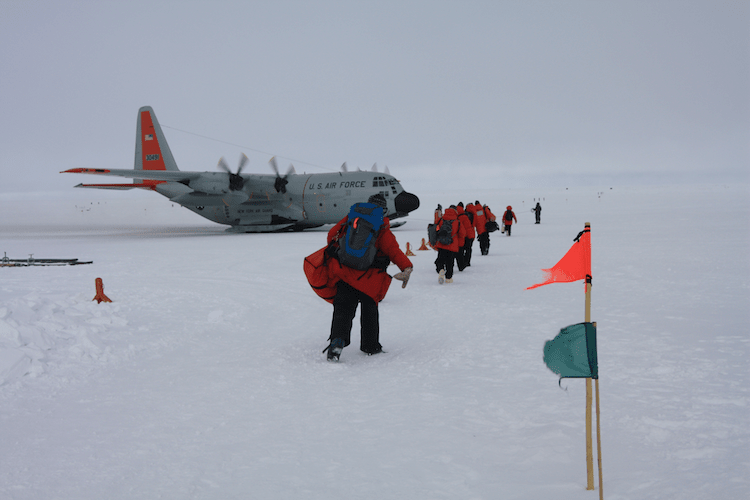Winter is back at the Amundsen-Scott South Pole Station in Antarctica. No more planes are expected to land in the next seven or eight months, but IceCube will continue operating steadily and reliably.
Ian Rees and Dag Larsen, the IceCube 2013–2014 winterovers, will stay at the Pole during the austral winter. They are part of a team of about 40 souls who will survive the unkind weather of Antarctica in the warm but isolated NSF-managed scientific station. Up north, a team of people in Madison and across the world is already making plans for the next austral summer for IceCube.

Expectations were high for this past season. The largest upgrade to IceCube’s hardware and software was completed on schedule. The new servers and readout computer upgrades brought new equipment to the Pole but also new opportunities for the scientists of the IceCube Collaboration, spread in a dozen or so countries around the world.
“IceCube data-taking and processing is secure for the coming years. We now also have more computing headroom, which will allow upgrades to the IceCube data acquisition system and still leave capacity for any future extensions of the detector,” says John Kelley, who manages the maintenance and operation of the IceCube detector.
The processing and filtering of the IceCube data is always a bottleneck for scientists, as data has to be transferred to the north by a limited-bandwidth satellite connection. The upgraded servers can process the incoming data almost twice as fast as before, and researchers will surely take advantage of this gain by developing more complex filtering algorithms that are tailored to the analyses.
IceCube also upgraded the uninterruptible power supplies (UPSs) in the IceCube lab that keep the detector running during short station power glitches and facilitate a clean system shutdown in case of extended power outages. Almost 3000 lbs of batteries were installed this year, completing the upgrade that was started last season. “We were able to reduce IceCube’s overall power consumption by installing high-efficiency UPSs and equipping our servers with power supplies that received the highest efficiency rating (“Titanium”) on the 80 Plus certification,” explains Ralf Auer, who is the system administrator for the South Pole data center.

As with every year, new measurements of the ice properties were also performed. This is done by flashing the LEDs in the frozen digital optical modules (DOMs) and measuring the response of the detector. The one completed in January 2014 was a more colorful calibration, though, since different colors were used to improve our knowledge of the ice properties.
Understanding how light propagates through the South Pole ice is key to measuring the direction and energy of the neutrinos IceCube detects. Most DOMs are equipped with blue-violet LEDs, the same color as in Blu-ray players. However, a few special color-LED DOMs, or cDOMs, can flash several other colors from the deep violet to cyan. Using light of several colors allows researchers to understand how the multi-hued blue light from neutrino interactions travels to the DOM.
Maintenance operations and upgrades to the detector have a down side. For a limited period of time, the detector performance decreases. Upgrading the data readout computers, the so-called DOMHubs, required powering off the sensors, which was done for several strings at a time so that the rest of the detector could keep running. This procedure reduced the “clean” or “golden” uptime—defined as every string of IceCube taking data—from 95% to 85% for a few weeks. However, the majority of the detector was still running, with an uptime of 97%. The upgrade of critical data acquisition servers was typically accomplished with less than five minutes of downtime.

This last season has been somewhat unusual in that the number of flights between McMurdo and the South Pole station was very low. This was a challenge for the station and for the experiments, like IceCube, that need to move everything and everyone in those planes. “By January 26, a date when the summer season is almost over, only 60 Herc flights had flown between McMurdo and the South Pole. That was just half of the flights that had been operated during the previous season. It was tough for IceCube, as many IceCubers were late on their way in or out from the Pole, but it was also threatening the normal operation of the station,” explains Jim Haugen, who is responsible for the IceCube South Pole planning and logistics.
Fuel to run everything at the South Pole also arrives there by plane. As the end of the austral summer neared, the amount of fuel to survive the long winter was insufficient. During the last three weeks of this season, 30 more flights were scheduled to ensure that everything would be ready for the frigid and dark days to come.
The winter is back at the Pole, temperatures are dropping, and the sun will be hiding soon. The good news is that the maintenance season is over, and IceCube is again performing almost perfectly.